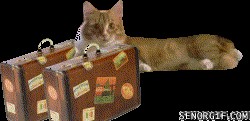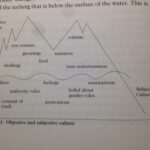The archetypal Hero, having ventured from home and endured trials, now faces the return journey, completing the cycle and culminating their adventure. We continue our exploration of the Hero’s Journey, focusing on the return and the hero’s new status. And for those needing a bit of encouragement, remember: May God Guide You In Your Quest Gif.
The Magic Flight
Alt text: Animated GIF depicting a frantic escape, symbolizing the hero’s urgent flight from danger after acquiring the Ultimate Boon.
With the Ultimate Boon in hand, the journey home begins. A hero favored by destiny and the gods may experience a smooth return, revitalizing the ordinary world. Moana exemplifies this: after restoring Te Fiti’s heart and balance to the sea, she receives a new boat as a divine reward, ensuring a safe passage home. Moana’s story cleverly inverts the traditional male heroic arc, where a warrior king confronts the supernatural before returning to rule, and it’s a welcome change.
However, heroes who acquire their boon through cunning or theft face a perilous chase. Jason and the Argonauts’ quest for the Golden Fleece offers a contrasting example. Aided by the enchantress Medea, who’s captivated by Jason, they escape. Medea, acting as his Supernatural Aid, thwarts their pursuers by murdering her brother and scattering his remains, forcing the keepers of the Fleece to halt and properly bury him, granting the Argo ample time to escape. This “obstacle-throwing” motif is common in folklore. Conversely, the Welsh hero Gwion Bach’s shape-shifting chase ends less favorably – by being eaten by a chicken.
Rescue From Without
Alt text: A man dramatically trapped in a “glass case of emotion” GIF, illustrating the need for external rescue in the hero’s journey.
As Joseph Campbell noted, sometimes a hero requires external assistance to return from their supernatural adventure. The world must intervene. The Supernatural Aid steps in when the Hero is unable, offering safe passage or a renewed start. The goddess Innana’s journey to the Underworld illustrates this: upon being transformed into a corpse, her messengers, acting on her prior instructions, prompt sympathetic gods to rescue and transform her back. Emotionally, Moana’s grandmother’s ghost acts as a Supernatural Aid, guiding her back to the path of saving the day when all seems lost.
This return from near-death, a recurring theme in Campbell’s work, often marks the recovery from the second act’s low point. In the Three Act Structure, it represents a resurgence of hope fueled by outside forces, leading into the decisive third act. In sports stories, this could be a crucial pep talk. A more unconventional example is Shrek 2, where Pinocchio, clad in ladies’ underwear, orchestrates the good guys’ prison break, setting the stage for the climactic resolution, complete with “I Need a Hero.”
Refusal of the Return/Crossing of the Return Threshold
These stages often coalesce, highlighting a central theme: a hero’s transformative experience may render a return to their former life impossible. “Crossing the Return Threshold” includes the tale of Oisin from Irish mythology, who marries the princess of the Land of Youth. Upon returning to Ireland after what he believes to be three years, he discovers that three hundred years have passed. Ireland has changed beyond recognition, and upon setting foot on the ground, he transforms into a blind old man.
King Muchukunda, after a cosmic nap, finds himself unable to reintegrate into society and becomes a hermit. Campbell notes that many heroes reside in the “blessed isle of the unaging Goddess of Immortal Being” because the world has changed, or the hero has undergone such a transformation that their ordinary world no longer fits.
Alt text: A confused expression depicted in an animated GIF, illustrating the hero’s disorientation upon returning to a changed world.
In Neverwhere, Richard returns to ordinary London but voluntarily descends back into the supernatural realm of London Below. Frodo, irrevocably changed by carrying the One Ring, leaves with the elves in The Lord of the Rings. Bilbo, in The Hobbit, returns to The Shire to find his neighbors attempting to sell his belongings, doubting his identity.
The Hero’s Journey, marked by multiple deaths and rebirths (symbolic or otherwise), inevitably alters the Hero’s perspective. Returning home won’t be the same. They see the world differently, and their peers perceive them differently; their sense of “normal life” is irrevocably altered.
Master of Two Worlds
Alt text: Celebratory confetti GIF, representing the joyful mastery of two worlds and the hero’s triumphant return.
“The disciple has been blessed with a vision transcending the scope of normal human destiny, and amounting to a glimpse of the essential nature of the cosmos.” The Hero gains cosmic ascension, existing simultaneously in both the ordinary and supernatural worlds. Narnia remains accessible in The Lion, the Witch, and the Wardrobe, but the children, now with a lifetime of knowledge within average bodies, have been transformed into royalty. They are planted back in the mundane world, but the door to the magic kingdom remains open.
Madoka and Homura in Madoka Magica embody different versions of this. Madoka ascends into a cosmic force, while Homura carries the burden/gift of cosmic knowledge, living an ordinary life while remembering the magical past, bridging reality and the supernatural.
Freedom to Live
Alt text: A person joyfully dancing and spinning in a GIF, representing the hero’s newfound freedom and celebration after completing their quest.
With peace restored, the elixir of life gifted, or the trophy won, it’s time for celebration. This is the resolution, the party scene, whether the fireworks in Star Wars or the wedding dance. After enduring trials, the Hero can finally relax. The mythic cycle is complete—they return to their starting point with new knowledge and power, inspiring those who hear their tale.
And so concludes the Hero’s Journey. While this is an abridged version, plenty of resources delve deeper into Campbell’s work. Christopher Vogler’s practical guide, the Spirits podcast’s episode, and TV Tropes all offer accessible explorations of the Hero’s Journey.
While not every trope appears in every story or in a specific order, echoes of these ideas resonate throughout linear media. The Three Act Structure aligns with the separation, initiation, and return arcs. These frameworks, though not rules, inform ancient and modern storytelling techniques, suggesting that audiences find them compelling and enduring. And as you embark on your own challenges, remember the encouragement: may God guide you in your quest gif.

